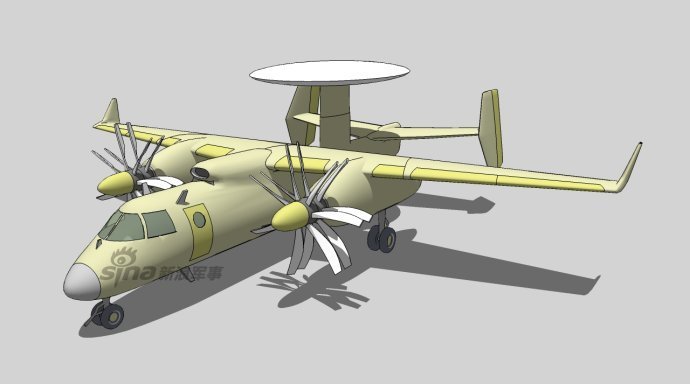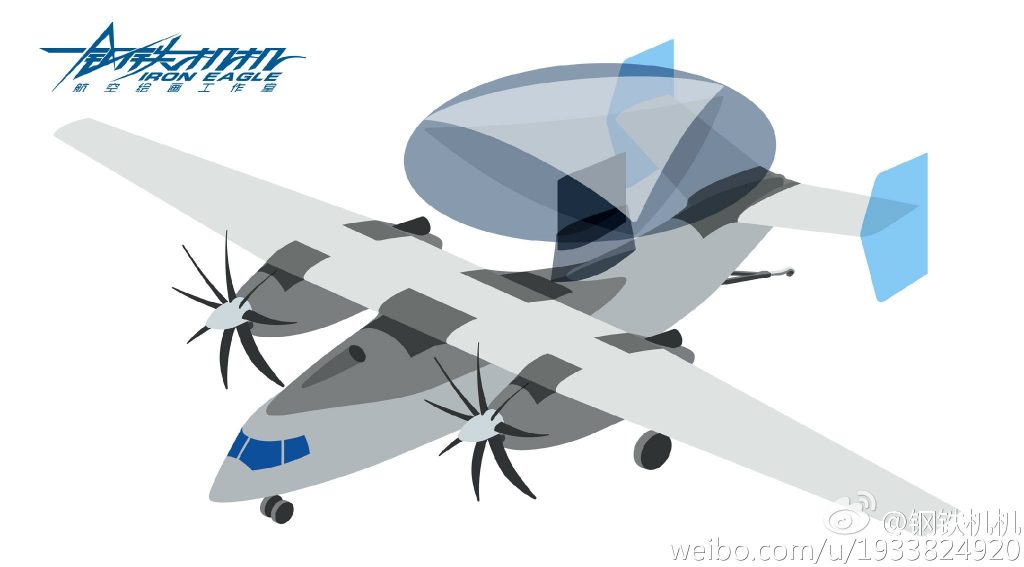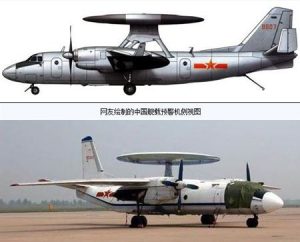The latest Update 2017 Jan. According to Henri the model is similar to E2C but it is not It is indigenous AEW. Wow with Chinese new year we have bumper harvest of new technology revelation
Last year
had spoken here of
, including studies conducted by industry so far and some prototypes were built. One of them would be at an advanced stage of development today and testing could have started, if we believe in the last elements made public.
In a text to express Chinese New Year wishes, the CAEIT Institute of the Chinese electronics group CETC has published a photo of an AWACS development team, in which the model of an AWACS embarked, next to that of
ZDK-03 sold in Pakistan. The ECCC is the main supplier of electronic equipment, including AWACS radars, for the Chinese Army.
A model of AWACS embedded in the AWACS development office of the CAEIT Institute (Source: ECCC)
The appliance model shows many similarities with the American AWACS embedded
E-2C , with a vertical tail to four planes and two turbo to 8 blades.
Because of the turbulence generated by the radome and its support on the back of an AWACS, the longitudinal stabilizing capacity of the conventional vertical tailplane is greatly reduced. To remedy this problem, engineers can increase the height (in height or width) of the empennage in question so that the latter "exits" the zone of influence of the turbulences. This is the solution chosen by the
Yak-44 , AWACS board who should join the Soviet Ulyanovsk class aircraft carrier.
However, in the case of modern AWACS, which must enter the hangar of an aircraft carrier where every meter is precious, increasing size is not an ideal solution, and it is for this reason That the E-2 for example, and now the Chinese, have chosen a better compromise which consists of multiplying the number of vertical planes.
In this regard, the Institute of AVIC Xi'an 603 Group, designer of many Chinese military aircraft such as fighter-bomber
JH-7 and the transport aircraft
Y-20 , tabled in November 2013 a patent on a new Vertical 4-plane tailplane to meet the needs of an on-board AWACS that must be able to take off in strong lateral winds, to land at low speed and at high incidence, and to continue flying with the loss of one of the two engines.
One can notice its difference with the same type of vertical empennage of the American E-2C. This is probably due to a different design of the radome, the support and the cell of the aircraft.
The vertical tail of the E-2C (left) and that of the Chinese design.
Apart from these two institutional elements, a photo taken by a spotter in Wuhan shows that a new model is now on the deck of the "concrete carrier". The latter is a platform of simulation of electromagnetic compatibility of the Institute 701 of the Chinese naval group CSIC.
On the concrete aircraft carrier of the 701 Institute in Wuhan is a new AWACS embedded model.
We can see in this picture the presence of three models, those of the onboard fighter
J-15 , the naval helicopter
Z-18 , and on-board AWACS.
The latter, which resembles the demonstrator
JZY-01 built by the Institute and the XAC 603 in 2005, measures at least within 18 meters if we take the Z-18 on the side as a reference.
The Embedded AWACS Demonstrator JZY-01
The appearance of this model suggests that the 701 Institute, the designer of the 3rd Chinese carrier, would have started the electromagnetic compatibility tests with all the devices that could be on the Chinese CATOBAR.
Note that the first catapult launch tests, steam and electromagnetic (EMALS), have already begun to naval aviation training center in Xingcheng, led by the staff of the Chinese navy (see our article "
"of November).
Finally, another patent filed by the Institute 603 of AVIC in May 2016 on
( "drop test" in English), seems to prove that the development of Chinese new board AWACS would be entered In the advanced testing phase.
The video below illustrates several "drop tests" of different aircraft:
In summary, with these new data to the radar operator (the group CAEIT Institute ECCC), the manufacturer (the Insitute 603 of AVIC Group) and the designer of the first Chinese aircraft prote catobar Type 002 (Institute 701 CSIC group), there is reason to believe that the new Chinese AWACS, destined for the 3rd Chinese aircraft carrier whose construction is in full preparation, will not be long to show itself to the public. It is estimated that its development should end no later than 2021 or 2022, when Type 002 will be delivered to the Chinese Navy.
To be continued.
Henri K.





